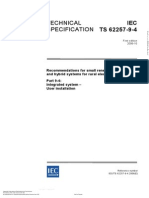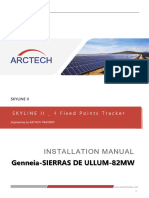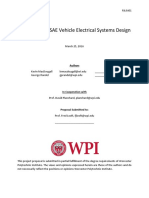Technical Specification: IEC TS 62257-2
Technical Specification: IEC TS 62257-2
Uploaded by
Paul RamosCopyright:
Available Formats
Technical Specification: IEC TS 62257-2
Technical Specification: IEC TS 62257-2
Uploaded by
Paul RamosOriginal Title
Copyright
Available Formats
Share this document
Did you find this document useful?
Is this content inappropriate?
Copyright:
Available Formats
Technical Specification: IEC TS 62257-2
Technical Specification: IEC TS 62257-2
Uploaded by
Paul RamosCopyright:
Available Formats
TECHNICAL
SPECIFICATION
IEC
TS 62257-2
First edition
2004-05
Recommendations for small renewable energy
and hybrid systems for rural electrification
Part 2:
From requirements to a range of
electrification systems
IEC 2004 Copyright - all rights reserved
No part of this publication may be reproduced or utilized in any form or by any means, electronic or
mechanical, including photocopying and microfilm, without permission in writing from the publisher.
International Electrotechnical Commission, 3, rue de Varemb, PO Box 131, CH-1211 Geneva 20, Switzerland
Telephone: +41 22 919 02 11 Telefax: +41 22 919 03 00 E-mail: inmail@iec.ch Web: www.iec.ch
Com mission Electrotechnique Internationale
International Electrotechnical Com m ission
PRICE CODE
XB
For price, see current catalogue
TS 62257-2 IEC:2004(E)
CONTENTS
FOREWORD...........................................................................................................................5
INTRODUCTION .....................................................................................................................7
1
Scope ...............................................................................................................................8
Normative references........................................................................................................8
Terms and definitions .......................................................................................................9
Methodology for non technical preliminary studies ........................................................... 10
4.1
Place and role of preliminary studies in a decentralized rural electrification
project ................................................................................................................... 10
4.2 Specifications of the preliminary study ................................................................... 10
4.3 The stages of a socio-economic study.................................................................... 15
Classification of electrification systems ........................................................................... 15
5.1 Introduction to a range of systems ......................................................................... 15
5.2 Users requirements ............................................................................................... 16
5.3 Typology of qualitative requirements ...................................................................... 16
5.4 Typology of quantitative requirements .................................................................... 17
5.5 Classification for electricity services provided........................................................ 18
5.6 Assisted selection of production subsystem ........................................................... 18
5.7 Typology of decentralized electrification systems ................................................... 18
Electrification systems architecture ................................................................................. 21
6.1
6.2
6.3
6.4
6.5
6.6
6.7
General ................................................................................................................. 21
General presentation of isolated electrification systems.......................................... 21
Combining subsystems .......................................................................................... 22
Functional diagrams .............................................................................................. 24
Related references ................................................................................................ 25
Limits between production, distribution and demand/application subsystems .......... 25
Summary of the different electrification system types ............................................. 25
Annex A (informative) Stages of a socio-economic study (see Clause 4) ................................ 26
A.1 General .......................................................................................................................... 26
A.2 Preparation phase .......................................................................................................... 26
A.3 Drawing up of the questionnaires, choice of surveyors and choice of sample ................... 27
A.4 Conducting the survey - Analysis of the results................................................................ 27
A.5 Extrapolation of the results ............................................................................................. 27
Annex B (informative) Analysis of the type of receivers installed versus types of use and
demonstrating seasonable variability (where applicable) (see Clause 5) ................................. 28
B.1 Domestic use.................................................................................................................. 28
B.2 Analysis of the type of receivers versus usage types ....................................................... 30
Annex C (informative) Supply quality indicators for isolated electrification systems (see
Clause 5) .............................................................................................................................. 32
TS 62257-2 IEC:2004(E)
Annex D (informative) Assisted selection of production subsystem (see Clause 5) ................. 34
D.1 Characteristics of possible production subsystems .......................................................... 34
D.2 Assisted selection of a decentralized production system suited to the requirement........... 34
Annex E (informative) Functional diagrams (See Clause 6) .................................................... 36
E.1 Glossary of symbols........................................................................................................ 36
E.2 Architectures of systems ................................................................................................. 37
Figure 1 Example of the content of a non technical preliminary study .................................. 11
Figure 2 Systems architecture and dispatchable energy ...................................................... 19
Figure 3 General configuration of an electrification system.................................................. 23
Figure A.1 Flowchart of the stages of a socio economic study............................................. 26
Figure D.1 Better adequacy of production subsystems solutions with supply
availability and daily duration of service ................................................................................. 35
Figure E.1 Type T 1 I-a system ............................................................................................. 38
Figure E.2 Type T 1 I-b system ............................................................................................. 39
Figure E.3 Type T 1 I-c system ............................................................................................. 40
Figure E.4 Type T 1 I-d system ............................................................................................. 41
Figure E.5 Type T 2 I system ................................................................................................ 43
Figure E.6 Type T 3 I-a system ............................................................................................. 45
Figure E.7 Type T 3 I-b system ............................................................................................. 46
Figure E.8 Type T 4 I system ................................................................................................ 48
Figure E.9 Type T 5 I system ................................................................................................ 49
Figure E.10 Type T 6 I system .............................................................................................. 50
Figure E.11 General architecture of a micropower plant supplying a microgrid .................... 52
Figure E.12 Type T 2 C system ............................................................................................. 53
Figure E.13 Type T 3 C-a system .......................................................................................... 55
Figure E.14 Type T 3 C-b system .......................................................................................... 56
Figure E.15 Type T 4 C-a system .......................................................................................... 58
Figure E.16 Type T 4 C-b system .......................................................................................... 59
Figure E.17 Type T 5 C system ............................................................................................. 61
Figure E.18 Type T 6 C system ............................................................................................. 63
Table 1 Application types and types of uses........................................................................ 16
Table 2 Expected quality of the supply ................................................................................ 17
Table 3 Synthesis of quantitative requirements/category (examples of type of user
and use) ............................................................................................................................... 17
Table 4 Typology of decentralized electrification systems.................................................... 18
Table 5 Preliminary range of relevant (as a minimum) decentralized electrification
systems ................................................................................................................................ 20
Table 6 Recapitulation of characteristics of different types of isolated electrification
systems ................................................................................................................................ 25
Table C.1 Combined categorization .................................................................................... 32
Table C.2 Service specification (example) .......................................................................... 33
TS 62257-2 IEC:2004(E)
Table D.1 Principles and characteristics of production subsystems ..................................... 34
Table E.1 Glossary of symbols ........................................................................................... 36
Table E.2 List of cases, type T 1 I ......................................................................................... 37
Table E.3 List of cases, type T 3 I ......................................................................................... 44
Table E.4 List of cases, type T 3 C ....................................................................................... 54
Table E.5 List of cases, type T 4 C ....................................................................................... 57
TS 62257-2 IEC:2004(E)
INTERNATIONAL ELECTROTECHNICAL COMMISSION
____________
RECOMMENDATIONS FOR SMALL RENEWABLE ENERGY
AND HYBRID SYSTEMS FOR RURAL ELECTRIFICATION
Part 2: From requirements to a range of electrification systems
FOREWORD
1) The International Electrotechnical Commission (IEC) is a worldwide organization for standardization comprising
all national electrotechnical committees (IEC National Committees). The object of IEC is to promote
international co-operation on all questions concerning standardization in the electrical and electronic fields. To
this end and in addition to other activities, IEC publishes International Standards, Technical Specifications,
Technical Reports, Publicly Available Specifications (PAS) and Guides (hereafter referred to as IEC
Publication(s)). Their preparation is entrusted to technical committees; any IEC National Committee interested
in the subject dealt with may participate in this preparatory work. International, governmental and nongovernmental organizations liaising with the IEC also participate in this preparation. IEC collaborates closely
with the International Organization for Standardization (ISO) in accordance with conditions determined by
agreement between the two organizations.
2) The formal decisions or agreements of IEC on technical matters express, as nearly as possible, an international
consensus of opinion on the relevant subjects since each technical committee has representation from all
interested IEC National Committees.
3) IEC Publications have the form of recommendations for international use and are accepted by IEC National
Committees in that sense. While all reasonable efforts are made to ensure that the technical content of IEC
Publications is accurate, IEC cannot be held responsible for the way in which they are used or for any
misinterpretation by any end user.
4) In order to promote international uniformity, IEC National Committees undertake to apply IEC Publications
transparently to the maximum extent possible in their national and regional publications. Any divergence
between any IEC Publication and the corresponding national or regional publication shall be clearly indicated in
the latter.
5) IEC provides no marking procedure to indicate its approval and cannot be rendered responsible for any
equipment declared to be in conformity with an IEC Publication.
6) All users should ensure that they have the latest edition of this publication.
7) No liability shall attach to IEC or its directors, employees, servants or agents including individual experts and
members of its technical committees and IEC National Committees for any personal injury, property damage or
other damage of any nature whatsoever, whether direct or indirect, or for costs (including legal fees) and
expenses arising out of the publication, use of, or reliance upon, this IEC Publication or any other IEC
Publications.
8) Attention is drawn to the Normative references cited in this publication. Use of the referenced publications is
indispensable for the correct application of this publication.
9) Attention is drawn to the possibility that some of the elements of this IEC Publication may be the subject of
patent rights. IEC shall not be held responsible for identifying any or all such patent rights.
The main task of IEC technical committees is to prepare International Standards. In
exceptional circumstances, a technical committee may propose the publication of a technical
specification when
the required support cannot be obtained for the publication of an International Standard,
despite repeated efforts, or
the subject is still under technical development or where, for any other reason, there is the
future but no immediate possibility of an agreement on an International Standard.
Technical specifications are subject to review within three years of publication to decide
whether they can be transformed into International Standards.
IEC 62257-2, which is a technical specification, has been prepared by IEC technical committee
82: Solar photovoltaic energy systems.
This technical specification is to be used in conjunction with IEC 62257 series.
TS 62257-2 IEC:2004(E)
The text of this technical specification is based on the following documents:
Enquiry draft
Report on voting
82/302/DTS
82/320/RVC
Full information on the voting for the approval of this technical specification can be found in the
report on voting indicated in the above table.
This publication has been drafted in accordance with the ISO/IEC Directives, Part 2. It was
developed in cooperation with other IEC technical committees and subcommittees dealing with
renewable energies and related matters, namely technical committee 21 ("Secondary cells and
batteries"), subcommittee 21A ("Secondary cells and batteries containing alkaline or other nonacid electrolytes"), technical committee 64 ("Electrical installations and protection against
electric shock"), technical committee 88 ("Wind turbines"), and others.
This document is based on IEC/PAS 62111(1999); it cancels and replaces the relevant parts of
IEC/PAS 62111.
The committee has decided that the contents of this publication will remain unchanged until
2007. At this date, the publication will be
reconfirmed;
withdrawn;
replaced by a revised edition, or
amended.
A bilingual version of this publication may be issued at a later date.
TS 62257-2 IEC:2004(E)
INTRODUCTION
The IEC 62257 series intends to provide to different players involved in rural electrification
projects (such as project implementers, project contractors, project supervisors, installers, etc.)
documents for the setting up of renewable energy and hybrid systems with AC voltage below
500 V, DC voltage below 50 V and power below 50 kVA.
These documents are recommendations:
a) to choose the right system for the right place,
b) to design the system,
c) to operate and maintain the system.
These documents are focused only on rural electrification concentrating on but not specific to
developing countries. They shall not be considered as all inclusive to rural electrification. The
documents try to promote the use of renewable energies in rural electrification; they do not
deal with clean mechanisms development at this time (CO 2 emission, carbon credit, etc.).
Further developments in this field could be introduced in future steps.
This consistent set of documents is best considered as a whole with different parts
corresponding to items for safety, sustainability of systems and at the lowest life cycle cost as
possible. One of the main objectives is to provide the minimum sufficient requirements,
relevant to the field of application that is: small renewable energy and hybrid off-grid systems.
The purpose of this part of the IEC 62257 series is to propose a range of renewable energy
based electrification systems able to meet the requirements of customers identified in the field
of decentralized rural electrification projects.
TS 62257-2 IEC:2004(E)
RECOMMENDATIONS FOR SMALL RENEWABLE ENERGY
AND HYBRID SYSTEMS FOR RURAL ELECTRIFICATION
Part 2: From requirements to a range of electrification systems
1 Scope
The scope of this part of the IEC 62257 series is to propose a methodological approach for the
setting up and carrying out of socio-economic studies as part of the framework of decentralized
rural electrification projects. It is addressed to project teams and in particular to experts in
charge of socio-economic studies in international projects.
The amount of detail gathered and the requisite number of experts needed would depend on
the scale of the proposed project. For large projects involving many households, a detailed
study would be required, for a project which involves a single or few households, the study
could be truncated.
The information coming from such preliminary studies could be used for several purposes,
such as more complete economic and financial studies of the electrification project.
This part of IEC 62257 also provides some structures as technical solutions that could be
recommended, depending on the qualitative and quantitative energy demands, consistent with
the needs and financial situation of the customers.
Then, in relation with each model of the proposed range of systems, electrical architectures are
proposed to technical project managers to assist in designing the systems.
2 Normative references
The following referenced documents are indispensable for the application of this document. For
dated references, only the edition cited applies. For undated references, the latest edition of
the referenced document (including any amendments) applies.
IEC 60617 (all parts)[DB] 1, Graphical symbols for diagrams
IEC 62257-1, Recommendations for small renewable energy and hybrid systems for rural
electrification Part 1: General introduction to rural electrification
IEC 62257-3, Recommendations for small renewable energy and hybrid systems for rural
electrification Part 3: Project development and management 2
IEC 62257-4, Recommendations for small renewable energy and hybrid systems for rural
electrification Part 4: System selection and design 2
IEC 62257-5, Recommendations for small renewable energy and hybrid systems for rural
electrification Part 5: Safety rules 2
___________
1 DB refers to the IEC on-line database.
2 Under consideration.
TS 62257-2 IEC:2004(E)
IEC 62257-6, Recommendations for small renewable energy and hybrid systems for rural
electrification Part 6: Acceptance, operation, maintenance and replacement 2
IEC 62257-7, Recommendations for small renewable energy and hybrid systems for rural
electrification Part 7: Technical specifications: generators 2
IEC 62257-8, Recommendations for small renewable energy and hybrid systems for rural
electrification Part 8: Technical specifications: batteries and converters 2
IEC 62257-9, Recommendations for small renewable energy and hybrid systems for rural
electrification Part 9: Technical specifications: integrated systems 2
IEC 62257-10, Recommendations for small renewable energy and hybrid systems for rural
electrification Part 10: Technical specifications: energy manager 2
IEC 62257-11, Recommendations for small renewable energy and hybrid systems for rural
electrification Part 11: Technical specifications: considerations for grid connection 2
IEC 62257-12, Recommendations for small renewable energy and hybrid systems for rural
electrification Part 12: Other topics 2
3 Terms and definitions
For the purposes of this part of the IEC 62257 series, the following terms and definitions apply.
3.1
REN
renewable energy
3.2
hybrid system
multi-sources system with at least two kinds of technologies
3.3
dispatchable power system
source, generator, system is dispatchable if delivered power is available at any specified time
(for example, a genset is a dispatchable system, REN generator is usually a non dispatchable
power system)
3.4
non dispatchable power system
a non dispatchable system is resource dependent; power might not be available at a specified
time
3.5
storage
storage of energy produced by one of the generators of the system and which can be
reconverted through the system to electricity
3.6
micropower plant
power plant that produces less than 50 kVA through the use of a single resource or hybrid
system
___________
2
Under consideration.
You might also like
- Iec TS 62257-4-2015Document76 pagesIec TS 62257-4-2015Ronel Buenviaje100% (2)
- Green ProtectDocument182 pagesGreen ProtectLuka KosticNo ratings yet
- Huawei Anti-PID SolutionDocument3 pagesHuawei Anti-PID SolutionJaime Andres Herrera RestrepoNo ratings yet
- Retest Guideline IEC61215 61646defDocument5 pagesRetest Guideline IEC61215 61646defeekamalesh8010No ratings yet
- SMAST - 150kW 02190 - 200929091953Document67 pagesSMAST - 150kW 02190 - 200929091953David GarciaNo ratings yet
- TÜV - Additional Requirements For Supplementary Rating and Qualification of Bifacial PV-modules - SNEC 2018Document29 pagesTÜV - Additional Requirements For Supplementary Rating and Qualification of Bifacial PV-modules - SNEC 2018Miguel GarzaNo ratings yet
- IEEE STD 1313.1-1996Document18 pagesIEEE STD 1313.1-1996Paul RamosNo ratings yet
- PD Iec TS 60904-1-2-2019 - (2019-02-24 - 09-49-44 Am)Document22 pagesPD Iec TS 60904-1-2-2019 - (2019-02-24 - 09-49-44 Am)Arbaaz KhanNo ratings yet
- Technical Specification: IEC TS 62257-1Document18 pagesTechnical Specification: IEC TS 62257-1ingesolarNo ratings yet
- Mechanism Design For Walking Typed Solar Panel-Cleaning Robot Using Triple Driving LinesDocument19 pagesMechanism Design For Walking Typed Solar Panel-Cleaning Robot Using Triple Driving LinesIAES International Journal of Robotics and AutomationNo ratings yet
- Inspection and Testing Guidelines For Large Scale SolarDocument38 pagesInspection and Testing Guidelines For Large Scale Solarshameerali20No ratings yet
- Iec 61701 2020Document12 pagesIec 61701 2020Veronica GozdalskaNo ratings yet
- Cigre 015Document23 pagesCigre 015emilioaraNo ratings yet
- RE 615 Tech 756887 ENm PDFDocument1,224 pagesRE 615 Tech 756887 ENm PDFKiran KarthikNo ratings yet
- 55MWCombined Cycle Power PlantDocument12 pages55MWCombined Cycle Power PlantDealCurryNo ratings yet
- Iecre Od 402Document31 pagesIecre Od 402EngineerNo ratings yet
- CIRCULAR # 02 - Pre Tender Clarification # 01 - T. 105-2022Document5 pagesCIRCULAR # 02 - Pre Tender Clarification # 01 - T. 105-2022Kumar NagarajanNo ratings yet
- Notice Inviting Tenders: NIT No. 02/RUVNL/2022 Dated 17.10.2022Document55 pagesNotice Inviting Tenders: NIT No. 02/RUVNL/2022 Dated 17.10.2022Siddharth RoshanNo ratings yet
- Saso Iec 61646-Ed2 0-EnDocument43 pagesSaso Iec 61646-Ed2 0-EnBrahadeesh Perinkolam MuraliNo ratings yet
- Iec 63056-2020Document22 pagesIec 63056-2020za shNo ratings yet
- Compendium CEA July 2024Document519 pagesCompendium CEA July 2024jefoc46814No ratings yet
- A Nexans Company: Catalogue 2009Document31 pagesA Nexans Company: Catalogue 2009Mosa Elnaid ElnaidNo ratings yet
- IEC 60947-1 2007 Trang 1.46.47Document3 pagesIEC 60947-1 2007 Trang 1.46.47Hop100% (1)
- IEC 60870 5 102 Intop ACP ENG PDFDocument30 pagesIEC 60870 5 102 Intop ACP ENG PDFMessias De Oliveira SantosNo ratings yet
- Breakout Session 1: Asset Management and O&M Standardization: Process, Status Quo and Next StepsDocument14 pagesBreakout Session 1: Asset Management and O&M Standardization: Process, Status Quo and Next StepsLaima KlemasNo ratings yet
- Iec 60904 7 2019Document11 pagesIec 60904 7 2019blueuniverseloverlanNo ratings yet
- Walv 10K Iec62619Document26 pagesWalv 10K Iec62619kogyiaungmovieNo ratings yet
- Induction Loops Formed in A PV InstallationDocument6 pagesInduction Loops Formed in A PV InstallationchrisNo ratings yet
- P64x - EN M - C63 Version 05 - Last One PDFDocument828 pagesP64x - EN M - C63 Version 05 - Last One PDFFrancis IlardeNo ratings yet
- Iec TS 62257Document23 pagesIec TS 62257AriefBukhari'abhi'100% (1)
- MB PV Rooftop EN WebDocument20 pagesMB PV Rooftop EN WebLambert LambrintoNo ratings yet
- Technical Specification: IEC TS 62257-9-4Document28 pagesTechnical Specification: IEC TS 62257-9-4Guillermo Gonzales AmayaNo ratings yet
- SkyLine II Installation Manual Genneia-SIERRAS de ULLUM-82MWDocument57 pagesSkyLine II Installation Manual Genneia-SIERRAS de ULLUM-82MWFlorencia BaroveroNo ratings yet
- Field Issues in PV Modules - PDFDocument5 pagesField Issues in PV Modules - PDFPaavalan gNo ratings yet
- Solar Professor-PV101-Types of Solar PDFDocument13 pagesSolar Professor-PV101-Types of Solar PDFSami Al-aminNo ratings yet
- IEC 60364-3 Electrical Installations of BuildingsDocument47 pagesIEC 60364-3 Electrical Installations of Buildingssalahuddin.enggNo ratings yet
- Indian Electrical Equipment Including Consumer Electronics IndustryDocument50 pagesIndian Electrical Equipment Including Consumer Electronics IndustryThanuja BhaskarNo ratings yet
- SR EN IEC 62485-6 - 2021 - Acumulatori LI-IONDocument58 pagesSR EN IEC 62485-6 - 2021 - Acumulatori LI-IONIuliana TanaseNo ratings yet
- 2020 Solardrone Adherence To IEC TS StandardsDocument6 pages2020 Solardrone Adherence To IEC TS StandardsDaniel GnanaselvamNo ratings yet
- 2 5257997163895456335Document42 pages2 5257997163895456335galangrisky234No ratings yet
- BiTEC-whitepaper - The Bifacial Year PDFDocument16 pagesBiTEC-whitepaper - The Bifacial Year PDFNikhil MehtaNo ratings yet
- Iec 62109-1 - 2Document3 pagesIec 62109-1 - 2ivanNo ratings yet
- Crystalline Silicon Terrestrial Photovoltaic Cells - : Solar America Board For Codes and StandardsDocument22 pagesCrystalline Silicon Terrestrial Photovoltaic Cells - : Solar America Board For Codes and Standardsmihai_faur88No ratings yet
- Driesse 2020 From IEC 61853 Power Measurements To PV System SimulationsDocument47 pagesDriesse 2020 From IEC 61853 Power Measurements To PV System SimulationsJeanNo ratings yet
- En 50216-9 2009Document23 pagesEn 50216-9 2009Mahmoud ShaheenNo ratings yet
- SOLARPack 410 ManualDocument79 pagesSOLARPack 410 ManualRaul I. GarzaNo ratings yet
- Formula SAE Electrical System DesignDocument81 pagesFormula SAE Electrical System Designjohnson adamsNo ratings yet
- Scope of Work For The Supply and Installation of Solar Power SystemDocument12 pagesScope of Work For The Supply and Installation of Solar Power SystemAzizullah AlizayNo ratings yet
- 60W 120W 160W LED Solar Street Light PIR Motion Sensor Outdoor GardeDocument21 pages60W 120W 160W LED Solar Street Light PIR Motion Sensor Outdoor Gardemohd sirajuddinNo ratings yet
- Iec TS 62257-7-2008Document18 pagesIec TS 62257-7-2008Yassine BecharNo ratings yet
- DTTN Dt2 PC Met PW 0003 ADocument8 pagesDTTN Dt2 PC Met PW 0003 ATariq Ali SialNo ratings yet
- International Standard: Norme InternationaleDocument19 pagesInternational Standard: Norme Internationalewwahib2No ratings yet
- 2018 CIGRE SESSION Technical - Programme June15thDocument34 pages2018 CIGRE SESSION Technical - Programme June15thVenkatasubramanian IyerNo ratings yet
- 1 2 3 4 5 CFC For S7 Continuous Function Chart Simatic: Appendices ManualDocument126 pages1 2 3 4 5 CFC For S7 Continuous Function Chart Simatic: Appendices ManualBatchmanNo ratings yet
- Iec 61868Document107 pagesIec 61868panicea_35No ratings yet
- Advisory Guide: Decentralized Inverter Technology in Large-Scale PV PlantsDocument48 pagesAdvisory Guide: Decentralized Inverter Technology in Large-Scale PV PlantsPablo Omar Luz PedemonteNo ratings yet
- AFCI Technical White PaperDocument16 pagesAFCI Technical White PaperSon NguyenNo ratings yet
- Annex - VP Structures and Module InstallationDocument48 pagesAnnex - VP Structures and Module InstallationsaamehbenhelelNo ratings yet
- 1 PBDocument253 pages1 PBsofyan_shahNo ratings yet
- A New Simple Analytical Method For Calculating The Optimum Inverter Size in Grid Connected PV PlantsDocument8 pagesA New Simple Analytical Method For Calculating The Optimum Inverter Size in Grid Connected PV PlantsrcpyalcinNo ratings yet
- IEC 60865-1-1993 Shot-Circuit Current-Calculation of EffectsDocument120 pagesIEC 60865-1-1993 Shot-Circuit Current-Calculation of EffectsPaul Ramos100% (1)
- Safety Data Sheet: 1. IdentificationDocument8 pagesSafety Data Sheet: 1. IdentificationPaul RamosNo ratings yet
- Icea S 66 524 Insul - 2Document2 pagesIcea S 66 524 Insul - 2Paul RamosNo ratings yet
- We G Catalog CompleteDocument476 pagesWe G Catalog CompletePaul RamosNo ratings yet
- IEC 61660-1 - CC RectDocument5 pagesIEC 61660-1 - CC RectPaul RamosNo ratings yet
- Power System Stability and Control - Prabha KundurDocument269 pagesPower System Stability and Control - Prabha KundurPaul RamosNo ratings yet
- AllanGreenwood Capitulos 1 y 2Document48 pagesAllanGreenwood Capitulos 1 y 2Paul RamosNo ratings yet
- How To Use The New Features - Digsilent V14Document83 pagesHow To Use The New Features - Digsilent V14ccrrzzNo ratings yet
- Modelo 624Document2 pagesModelo 624Paul RamosNo ratings yet
- Digsilent DPL TutorialDocument62 pagesDigsilent DPL TutorialYuteeNo ratings yet
- Westinghouse - Electrical Trannd Distribution Reference Book 128Document1 pageWestinghouse - Electrical Trannd Distribution Reference Book 128Paul RamosNo ratings yet
- De JOYA Villanueva Residence Schedule of Construction ActualDocument1 pageDe JOYA Villanueva Residence Schedule of Construction ActualAdrian Marasigan ReyesNo ratings yet
- Strengthening Social Cohesion and A Common Identity in The Republic of MoldovaDocument53 pagesStrengthening Social Cohesion and A Common Identity in The Republic of Moldovavlad panfiliiNo ratings yet
- My Internship-Report at La Ruche Des Sciences Private SchoolDocument28 pagesMy Internship-Report at La Ruche Des Sciences Private SchoolMaroua LeeNo ratings yet
- Instructions - Digital PlannerDocument11 pagesInstructions - Digital PlannerMohamad FikreeNo ratings yet
- Call For Papers Iac 2022 2021-10-20 Final Print OnlineDocument33 pagesCall For Papers Iac 2022 2021-10-20 Final Print OnlineAngNo ratings yet
- Unity University: Course: OOSAD, Project Report Title: Tax Management SystemDocument10 pagesUnity University: Course: OOSAD, Project Report Title: Tax Management SystemTsegazeab ZinabuNo ratings yet
- Biomass As An Energy SourceDocument24 pagesBiomass As An Energy Sourceodebunmi taiwoNo ratings yet
- TMT250 Flyer 1.3Document4 pagesTMT250 Flyer 1.3Jennsett SastreNo ratings yet
- 3.equity Measurement & Management SystemDocument26 pages3.equity Measurement & Management SystemShobhit BoseNo ratings yet
- United States v. Samuel Desist, Frank Dioguardi, Jean Claude Lefranc, Jean Nebbia and Anthony Sutera, 384 F.2d 889, 2d Cir. (1967)Document23 pagesUnited States v. Samuel Desist, Frank Dioguardi, Jean Claude Lefranc, Jean Nebbia and Anthony Sutera, 384 F.2d 889, 2d Cir. (1967)Scribd Government DocsNo ratings yet
- CE-700 Working Group Initial Cessna 180Document7 pagesCE-700 Working Group Initial Cessna 180Elmer VillegasNo ratings yet
- Advanced Curriculum DevelopmentDocument139 pagesAdvanced Curriculum DevelopmentMary Rose GonzalesNo ratings yet
- Weberbloc Fix NDocument2 pagesWeberbloc Fix NCharbel AchkoutyNo ratings yet
- SporTrak Base enDocument74 pagesSporTrak Base enMatt StubbinsNo ratings yet
- InagroveDocument5 pagesInagroveJV GamoNo ratings yet
- "Research Is A Process of Steps Used To Collect Information To Increase Our Understanding of A Topic or An Issue." - John W. CreswellDocument2 pages"Research Is A Process of Steps Used To Collect Information To Increase Our Understanding of A Topic or An Issue." - John W. CreswellFrancees TambasenNo ratings yet
- The Expansion of The Christian KingdomsDocument5 pagesThe Expansion of The Christian KingdomsAlexiaSeleniaNo ratings yet
- Manufacturing Step in Ginger Oil ProcessingDocument3 pagesManufacturing Step in Ginger Oil ProcessingmilindNo ratings yet
- Elliott Wave - Short Term UpdateDocument12 pagesElliott Wave - Short Term UpdateNazerrul Hazwan KamarudinNo ratings yet
- AnestesiaDocument210 pagesAnestesiajose miguelNo ratings yet
- Édouard Schuré - WikiwandDocument7 pagesÉdouard Schuré - WikiwandDarci HallNo ratings yet
- Citizen Charter IndiaDocument5 pagesCitizen Charter Indiaritesh rachnalifestyleNo ratings yet
- Jugaad TechnologyDocument15 pagesJugaad TechnologySuresh KumarNo ratings yet
- TE-Road User and Vehicle CharacteristicDocument7 pagesTE-Road User and Vehicle CharacteristicVaibhav PatelNo ratings yet
- Project Report On Shopping ApplicationDocument118 pagesProject Report On Shopping ApplicationpassionatepriyaNo ratings yet
- Six Sigma Glossary PDFDocument36 pagesSix Sigma Glossary PDFmancheung6429100% (1)
- Pengaruh Pemberian Probiotik Lactobacillus Acidophilus Dan Bifidobacterium Terhadap Produksi Ayam Petelur Yang Diinfeksi Escherichia ColiDocument7 pagesPengaruh Pemberian Probiotik Lactobacillus Acidophilus Dan Bifidobacterium Terhadap Produksi Ayam Petelur Yang Diinfeksi Escherichia ColiMuhammad Dzaky AlhurryNo ratings yet
- GK TODAY Aug ObjectiveadcfeDocument78 pagesGK TODAY Aug ObjectiveadcfeArush SharmaNo ratings yet
- AP Psychology Chapter Nine UnitDocument84 pagesAP Psychology Chapter Nine UnitJonaLee FellerNo ratings yet
- NABARD Grade A B Syllabus Exam Pattern 2019 (Prelims - Main)Document8 pagesNABARD Grade A B Syllabus Exam Pattern 2019 (Prelims - Main)Parker SaomeNo ratings yet





































































































